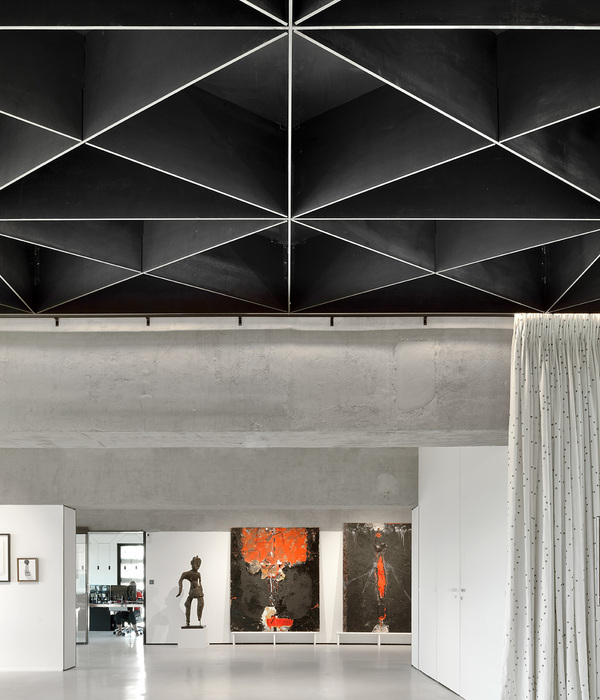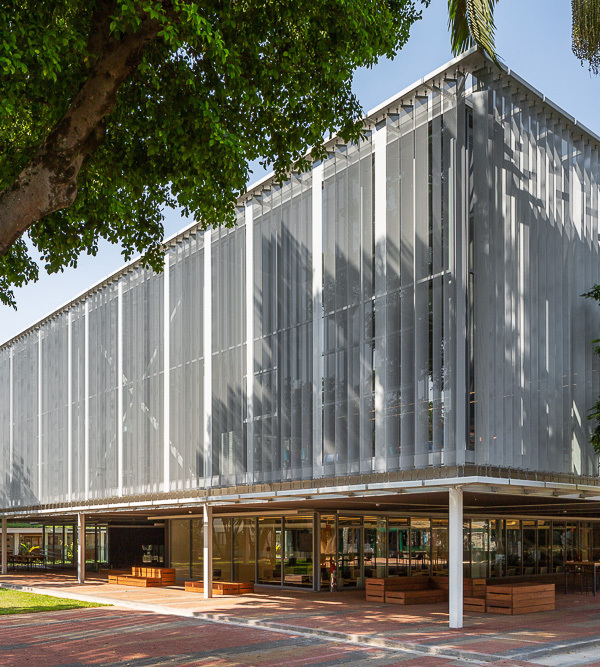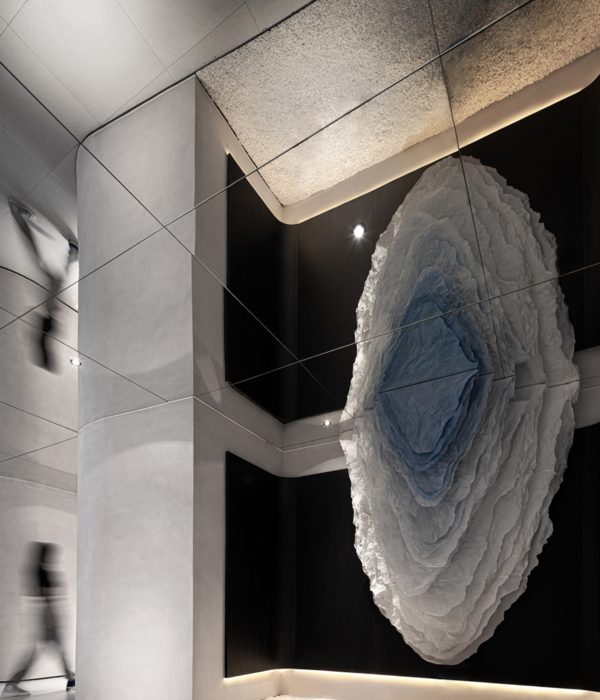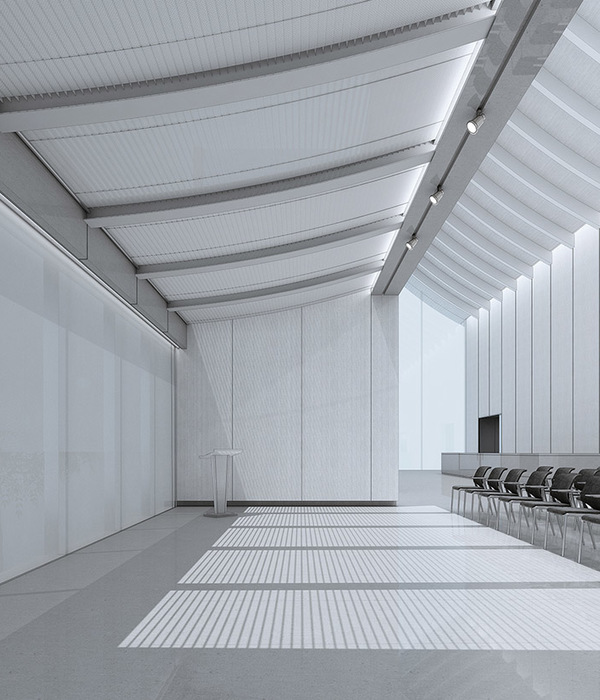“It’s a combination of re-vegetating the freeway and providing some art. The art serves as landmarks that help people orient themselves. Also, this corridor is clogged all times of the day, and this would help people cope with having to sit there. And it’s very doable because Atlanta has a history of doing these kinds of projects.”—2013 Professional Awards Jury
“该项目将高速公路的绿化和艺术结合起来。艺术装置作为路标帮助人们辨认方向。此外,由于该路段十分繁忙,该项目实施后将提高道路的通行性。亚特兰大对此类项目有着很丰富的历史经验,因此具有的很高可行性。”
—2013专业奖评审委员会
Museum of Freeway Art (MOFA) by
SWA Group
, Houston, TX 更多关于他们:
.
该项目力求建立一个重新改造和重新连接亚特兰大城市中心的蓝图,同时引发关于高速公路基础设施及其在城市中位置的全国性探讨。该项目通过把亚特兰大洲际公路75/85重塑为线性艺术长廊“高速公路艺术博物馆”,将城市高速公路重新定义为新的公共空间,并成为激活边缘区域、附近社区、甚至是整个城市的催化剂。
This project seeks to create a vision for repairing and reconnecting the core of Atlanta, while pressing the national discussion about the nature of
highway infrastructure and its place in the city. By re-branding Atlanta’s Interstate 75/85 Connector as a linear gallery, the “Museum of Freeway
Art”, the urban freeway is redefined as public space that becomes a catalyst for energizing its margins, the adjacent neighborhoods, and the city as
a whole.
▼总平面图 Site Plan.
项目背景
该项目的分析和规划区包含从亚特兰大市中心北端的高速公路I-75/I-85到南部特纳球场附近的I-20交流道之间的路段,总长5英里。路段上每天的车辆通行量高达300,000辆,老化的基础设施、混凝土挡土墙、匮乏的景观、低维护和被忽视的边缘区域成为该路段的显著特点。目前,该路段已经为亚特兰大带来了负面影响,不仅让整个城市在参观者心中留下不良印象,而且影响了整个城市肌理,进而影响城市中心的连通性、公共交通流量、旅游业、从而最终影响到税收和就业。由于该路段已经有很长的历史,在过去60年内经历了建造和重建,已经慢慢偏离亚特兰大的城市规划愿景。路段范围内已经无法看到城市中心的街景和公园;公路两旁的学校(乔治亚理工大学、乔治亚州立大学、埃默里大学、萨凡纳艺术设计学院)向反方向发展;停车场、空地等横亘在公路和城市之间。
分析
由于该路段具有重要的交通功能,因此我们不会让其消失,而是将它作为城市开放空间网络的变革性组成部分以及具备综合用途的公共基础设施。设计时首先分析了路段的环境和生态条件。团队对环境问题连同视觉连续性、安全性和连通性等进行了评估,并将分析结果以图表方式呈现出来,用来指导设计方案的规划。
亚特兰大的热岛效应高达8级,是国内热岛效应最严重的城市。每年,该路段会制造19亿加仑含空气微粒的降水。暴雨的袭击往往造成道路无法通行。另外每年车辆会排放30万公吨的二氧化碳。除了环境问题之外,该路段还带来了连通性差、健康、安全和城市规划等问题。从前的街区被孤立、人行道被切断,通往亚特兰大捷运(MARTA)的入口也与道路分离。
该项目最初通过度量分析法设定了设计目标,进而完成整个项目的设计。方案提出减少铺砌路面以最大程度上降低热增量和降水量;在原有和新增渗水区域内重建亚特兰大日益减少的城市森林;在路段横向和竖向上修建桥梁、人行步道和公园以增加城市连通性。
生态项目同样需要契合亚特兰大特殊的城市背景、丰富的历史和城市发展愿景。因此,团队在设计中植入了文化元素,体现了该路段积极的建设初衷,将与市民产生共鸣。整个设计将生态与引人注目的、极富表现力的艺术和文化形式相结合,最终促成了高速公路艺术博物馆(Museum of Freeway Art)
的诞生。
设计过程
该路段沿线建设的核心策略包括绿化、艺术、灯光和城市设计。这些策略通过为道路赋予深层次的内涵及提高视觉和通行体验来改变当前道路状况。绿化是该项目的基础。道路边缘以及立体交叉道的渗水空间将栽种绿植,成为活力无限、令人瞩目的城市森林地带。城市森林的南北两侧入口将精心打造出通往亚特兰大城市中心的道路。森林将沿着未使用的线状公共地带一直延伸到城市中心以提高视觉体验、充分利用闲置地产并充当城市景观的媒介。因空间限制或出于安全考虑无法布局城市森林的地段将采用垂直绿化策略来延续绿化主题。这些绿化策略起到促进区域可持续发展和净化空气的作用,有利于缓解道路上每天300,000辆车辆对环境产生的不利影响。
艺术与绿化、灯光等传统元素一起打造一个具有文化气息的高速公路艺术博物馆、一个顶级的艺术旅游目的地,改变人们对于在公共领域植入艺术元素的传统观念,提高民众的艺术鉴赏力。该方案在保障高速通行性和良好的视觉效果的基础上将该路段复杂的空间作为博物馆空间。挡土墙、桥梁、隧道和路段装饰元素成为博物馆的墙体和空间构架。形象的壁画、灯光、慢速视频及雕塑将展现亚特兰大的自然和文化史。与亚特兰大其他博物馆及文化基地相似,高速公路艺术博物馆也将会收藏永久藏品、并有会员、董事会、国家级别的馆长和博物馆商店。设计师们将焦点从高速公路转移到博物馆空间,从而找到了一个更为丰富、集中且更具变革性的设计方案。
未来,该路段将利用已有设施和高速公路艺术博物馆在上部和沿线打造新的城市空间。城市公园、人行道、轨道、人行天桥及其他发展项目将陆续启动。新元素嵌入城市肌理中,在建立新联系的同时让旧设施重焕光彩。公路墙壁上方将建设一条连接和城市和博物馆的艺术步道,展现一幅车辆和行人穿梭变化的图景。
过程
2011年5月至10月为期六个月的设计过程包括每月召开的有两个顾问团队参加的会议及一系列公众参与的活动。高层决议领导团队与由本地设计专家组成的创意团队共同探讨设计方案及施工方案。此外,外联工作包括社会媒体宣传,以及对重要的利益相关者、公共机构、当地政府、土地所有者、企业及公众进行采访或召开研讨会。外联工作产生了巨大的公共影响,极大提高了民众对于该项目的关注度和支持度。项目的最终文件包含了路段和附近地产的详细分析资料。项目的设计和提案以这些资料为基础进行规划,并在公众和股东参与的活动中予以公开。总规划中除了项目的宏观愿景之外,还会有针对近期工程的详细设计纲要及工程预算。在当地慈善组织、企业及政府的资助下,早期工程正在实施当中。
▼ 该路段的热岛效应、雨水、微粒物质和二氧化碳的排放为亚特兰大带来了严重的环境问题,同时不断减少的树冠覆盖面也对环境及亚特兰大“森林城市”的形象带来了负面影响。
The Connector’s heat island, storm water, particulate matter, and carbon emissions create serious environmental issues for Atlanta, while the declining tree canopy negatively affects the environment as well as Atlanta’s identity of the “City in the Forest.”
▼城市分析形成了道路两侧和城市范围内建设工程的基础。该项目提高了连通性和可达性;开放空间两侧是基础设施结构;此外该项目还能提高项目路段附近区域的品质。
Urban analysis was conducted to form a basis for interventions at both site and city scale. Connectivity and access to transit and open space was paired with an inventory of infrastructural architecture and opportunities for improvement at the sites adjacent to the Connector.
▼该设计的愿景是分步骤地重塑城市魅力。高速公路上将打造城市森林。由一系列独特公共空间组成的高速公路在城市之中建立了连接,实现了新的发展。
The vision is to reinvigorate the City in an achievable step by step process. Urban forests are restored within the right of way. The freeway is thenprogrammed as a sequence of unique public places. Urban connections are made and new development is realized.
▼在可预见的将来,该路段都将是亚特兰大最重要的基础设施区域。它以环境指标为基点,其改造方案将路段置于亚特兰大的整个城市背景中
来分析。
The Connector will remain Atlanta’s most defining piece of infrastructure for the foreseeable future. Using environmental metrics as a point of departure, a transformation strategy is devised that looks at the Connector in context of the greater City of Atlanta.
▼为了塑造一个成功的公共空间,该设计充分利用周围区域和城市的艺术气息。通过将景观、艺术、灯光和路标元素融为一体,打造了一个高速公路艺术博物馆。
To be successful as a public space, the design takes advantage of adjacencies and the City’s artistic aspirations. By weaving landscape, art, lighting, and way-finding elements into an overarching composition, the Connector becomes the Museum of Freeway Art (MoFA).
▼交叉道被转变成为有着清晰轮廓的森林通道,通道上种满本国植物和外来植物。道路边缘的渗水区域种植绿色植被、成为动物们的栖息之所,并提高了视觉的延续性和区域特色。竖向的葡萄藤墙壁极大延展了绿化空间。
Interchange spaces are converted to forest gateways planted with native and exotic species in legible design forms. Porous spaces along the Connector’s margins increase canopy, habitat, continuity, and identity. Vertical structures use vine walls to maximize greening.
▼基于新博物馆规划的艺术、自然和城市基础设施的战略性组合彻底颠覆了人们对于公共景观设计的传统观念。每一个因子都是影响整个城市的大系统的缩影。
Strategic integration of art, nature, and urban infrastructure under the patronage of the new museum radically expands the notion of surface application. Each generated instance of affect is a snapshot of a larger system that shocks, mends, and excites on the scale of the city.
▼ 高速公路艺术博物馆是一级艺术旅游景点,包含董事会、捐助团体、国家级别的馆长、永久藏品、旋转式展览和博物馆商店等完整的体系。博物馆的艺术活动将进一步充实并增强亚特兰大的艺术氛围。
The MoFA is a first order art tourism destination, complete with a board of directors, an endowment, a national level curator,a permanent collection, rotating exhibits, and a museum shop. Connector art events complement and strengthen the Atlanta art scene.
▼高速公路艺术博物馆是由一系列线型展馆组成,各展馆以不同的历史艺术时期为主题进行排列。边缘设置的辅助性艺术装置强化了该路段由单纯的绿化城市边缘向城市中心的角色转变。
MoFA is organized as a sequence of linear galleries themed according to art-historical representations of nature. The experiential transition from a greener city edge to the urban center and back is intensified by the collaborative artistic installations along the Connector’s edges.
▼路段建设和极其形象化的艺术展览的结合将城市和该路段连接成统一的整体。参观者以全新的视角看待城市,人行步道穿插在高速公路上的户外展廊之中。
By combining the architecture of the Connector with super graphic art, the City and the Connector merge into a single composition. Travelers see the City in a new light while pedestrians socialize in outdoor galleries above the freeway.
▼分阶段策略在最大程度上扩大了每一个新植入项目的时间及空间效用。早期的项目花费更高且更耗时。每一个阶段都是在前一阶段的基础上进行的。
The phasing strategy maximizes the effect of each intervention over time and space. Early win projects catalyze more expensive and time intensive projects. Each phase builds upon the excitement or effect of the previous phase.
▼确定了重点工程,并制定出详细的预算、设计纲要、材料规格及投资方,以确保工程按时竣工。
Priority projects have been identified, detailed cost estimates, design guidelines, material specifications, and funding opportunities have been established to ensure the first projects are implemented in a timely fashion.
▼在当地慈善组织、企业的资助下,早期工程正在实施当中。通过召开公众会议、向国家及地方相关机构提交材料、并与股东举行单独会议的方式以获得更广泛的支持。
Early implementation is underway with local philanthropic organizations joining forces with business districts to fund select portions of the project. Public meetings, presentation to state and local officials, and individual meetings with stakeholders were used to win support.
▼未来,该路段将利用已有设施和高速公路艺术博物馆在上部和沿线打造新的城市空间。城市公园、人行道、轨道、人行天桥及其他发展项目将陆续启动,在建立新联系的同时让旧设施重焕光彩。
Over time, new urban spaces will be created to take advantage of the Connector and the MoFA. Urban parks, promenades, trails, pedestrian bridges and development projects are the envisioned urban insertions that will make new connections and reinvigorating old ones.
▼路段边缘的公共区域、住宅和学校将在这片新建设的城市公共空间中扮演积极的角色;参观者和居民将看到一个以大都会为远景的城市基础设施建设项目。
Once the Atlanta public realm, private properties and institutions along the Connector’s margins will realize the positive attributes of this newly-found public space, visitors and residents alike will be able to re-imagine the role of infrastructure in metropolitan aspirations.
Background
The project involved analysis and visioning for the five-mile stretch of freeway from the I-75/I-85 merge on the north end of Midtown Atlanta to the I-20 interchange near Turner Field south of Downtown Atlanta. This vast expanse of pavement carries 300,000 vehicles per day and is marked by aging infrastructure, concrete retaining walls, limited landscaping and maintenance and neglected properties along its margins. In its current state, the Connector creates a decidedly negative environment for the City of Atlanta that damages both the visitor’s opinion of the City and its urban fabric. This in turn affects connectivity, transit ridership, tourism and, ultimately, tax revenues and jobs in the urban core. As the Connector was built and rebuilt over the last 60 years, it has slowly taken on a character that is divorced from the aspirations of the City of Atlanta. The well-tended streetscapes and parks of Downtown and Midtown Atlanta are absent from the Connector’s visual fabric. Academic institutions that line the Connector (Georgia Tech, Georgia State, Emory, SCAD) have turned their backs on what could be Atlanta’s front door. A DMZ-like zone of garages, vacant lands and service drives has emerged between the Connector and the City it intends to service.
Analysis
Because of the realities of transportation funding, the project will not seek to make the Connector disappear; rather it will use the Connector as a transformative piece of the City’s open space network. The freeway becomes mixed-use infrastructure that is perceived and embraced as public space.The design process began with an analysis of the environmental and ecological issues associated with the existing condition of the Connector. Environmental issues were assessed along with visual continuity, safety and connectivity. The results of these analyses were diagrammed and used to guide design solutions.
Atlanta suffers from an 8 degree heat island effect, the highest in the nation. Over 1.9 billion gallons of unfiltered storm water are created each year by the Connector’s paved surfaces. Downpours routinely flood the Connector making it impassable. Three-hundred thousand metric tons of carbon are created by vehicles traversing it. Aside from these environmental impacts, the Connector has created serious connectivity, health, safety and urban design problems. Historic neighborhoods are isolated, pedestrian routes severed and access to MARTA detached.
Goals were set by using analysis metrics as a point of departure for the ultimate design solution. Paving would be reduced to minimize heat gain and reduce storm water runoff. Newfound and existing permeable spaces would be used to rebuild Atlanta’s dwindling urban forest. Bridges, promenades and parks would be built across and along the Connector to increase urban connectivity.
An ecologically meaningful project also had to fit into the specific context of the City of Atlanta, its rich history and aspirations. A cultural analysis and inventory was created to guide the design toward solutions and forms that would resonate with the population and build upon the Connector’s nascent positive attributes. The result infused ecology with the striking and legible design forms of art and culture. Thus the Museum of Freeway Art (MOFA) was born.
Design Elements
The core strategies that will be employed along the length of the Connector involve greening, art, light and, ultimately, urban design interventions. These strategies are used to modulate and recalibrate the existing infrastructural surfaces of the freeway in a manner that adds depth and meaning to Connector experience, and by default, the visual—and physical—experience of the City.
Greening strategies form the foundation of the transformation. The permeable spaces along the Connector’s margins and within its immense interchanges will hold a vibrant, robust and legible urban forest canopy. Urban forests will be crafted to create gateways at the north/south entries into Atlanta’s urban core. The forests will follow threads of unused open space into the heart of the City, enhancing views, hiding vacant properties and forming a medium through which the City is viewed. Where space or safety considerations limit the inclusion of forests, vertical greening strategies will be employed to continue the thematic greening of the Connector and the City. While these greening strategies will have a nascent
effect on regional sustainability and clean air initiatives, they are not seen as offsetting the intensely negative effects of the 300,000 vehicles using the Connector daily.
Selected art will transcend traditional labels with all elements, greening, lighting and art, working together to create the Museum of Freeway Art (MOFA) – a first-order art tourism destination whose mission is to transform the Atlanta Connector and the national appreciation of art in the public realm. The museum is created by co-opting the complex spatial character of the Connector as a museum space crafted with both the high-speed traveler and the neighborhood viewer in mind. Retaining walls, bridges, tunnels and the furnishings of the Connector become a framework of museum walls and spaces. Super-graphic murals, lighting effects, slow-motion video and sculpture will be used to highlight the natural and
cultural history of Atlanta. Like its peer museums and cultural foundations in Atlanta, MOFA will have a permanent collection, membership, a board of directors, a national level curator and a museum shop. By refocusing the conversation about the Connector from that of freeway to a museum space, a much richer, intensive and transformative design solution can be achieved.
Over time, new urban spaces will be created above and along the Connector that seek to take advantage of the Connector and the MOFA. Urban parks, promenades, trails, pedestrian bridges and development projects are envisioned as a series of urban insertions that ripple through the City fabric, making new connections and reinvigorating old ones. An art walk is designed to hang above the Connector walls and connect the City to the museum while playing up the change in perspective of the museum between the car and the pedestrian.
The Process
During a six-month period between May and October 2011, the planning process involved monthly meetings with two advisory groups and a series of public involvement events and opportunities. A Leadership Team of high-level decision makers worked in tandem with a Creative Team of local design professionals to provide strategic advice on design and implementation. Additionally, outreach efforts employed social media and included frequent interviews and workshops with key stakeholders, public institutions, local government, landowners, business interests and the public. The process created significant “buzz” and resulted in an outpouring of public interest and support for the project. The project’s final document included detailed inventory and analysis of the Connector and adjacent properties. The design work and recommendations were built upon this data and informed by the public and stakeholder involvement process. In addition to the grand vision outlined in the plan, the consultant also created detailed design guidelines and cost estimates aimed at early-win projects that could be quickly funded and implemented. Early implementation is underway with local philanthropic organizations joining forces with business and government entities to fund specific projects. (VIA:
ASLA
)
{{item.text_origin}}












